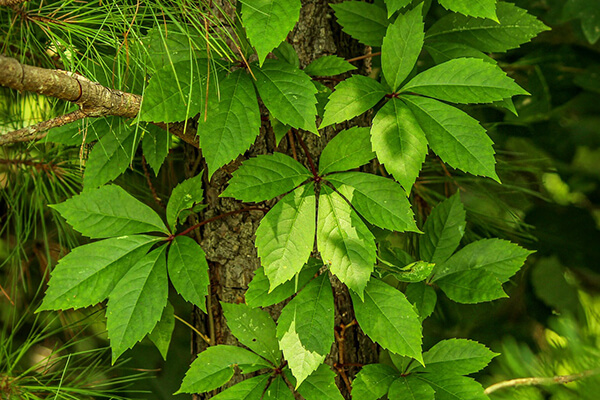The Virginia creeper is a woody vine that normally climbs up trees, fences, or what have you, and can also be used as a ground cover. In the latter instance, the Virginia creeper helps control soil erosion. However, the Virginia creeper can smother other plants and insert tendrils into any loose space in your windows, roof, or wherever it clings to. The rule of thumb is to avert any possible problem at the onset. Otherwise, it can cause you a lot of damage. The Virginia creeper needs frequent pruning to stop it from growing out of control.
General Information
The Virginia creeper blooms from June to August lasting about two to three weeks. The nectar and pollen of these flowers sometimes attract leaf-cutting bees. These flowers become green berries that contain two to three seeds. The color of the berries turns blue in the fall. During this time of the year, the Virginia creeper’s foliage also turns a beautiful red. You will need plenty of room as the Virginia creeper is a vigorous grower. Except for its first year, you can expect from six to ten feet of growth annually. It resembles the eastern poison ivy, so note the contrast.. Poison ivy has three leaflets; a fully developed Virginia creeper has five. Be also aware that cottontail rabbits and white-tailed deer like the Virginia creeper.
Propagation and Cultivation
Just like your regular houseplant ivy, you can take some tender tip cuttings and root the Virginia creeper in a container of water. When the cuttings become well rooted, you can plant at your desired location. Place the Virginia creeper seeds in either damp sand or peat moss to promote germination. Sow in the fall or in the spring about 3/8 of an inch in the soil, ten plants per square foot. In case of persistent drought, water the vine every week soaking the soil at least six inches. deep The Virginia creeper is a very fast grower. It can grow up to over 60 feet with a spread of over 50 feet.
Plant Hardiness
The Virginia creeper is quite hardy. It grows well from Zones 3 to 9, whether in full sun or partial shade. Although it prefers acidic soil, it will tolerate a broad range of soil conditions. There are no major concerns with pest or diseases with the Virginia creeper.
Medicinal Properties
The Virginia creeper has been utilized as a tonic and expectorant. It has also been used for rheumatic ailments. The roots can be used to help with diarrhea ailments, and the twigs and bark have been used to cure coughs.
To Remove the Virginia Creeper
It is very difficult to remove a Virginia creeper once it is established. It can literally damage your wall or kill other plants. You can try and trim the vine back to a stump and paint (not spray) it immediately with undiluted Roundup. It may still re-sprout. In that case, you need to cut the Virginia creeper again about one inch lower and repaint with the undiluted Roundup.









what colours do virginia creepers come in, and how long will it take to grow up a12 foot wall. Thanks Chris